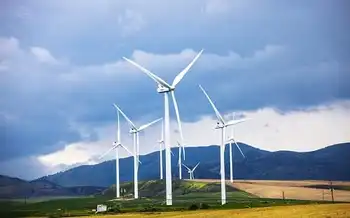In bid to go green, U.S. can look to Danes
By United Press International
High Voltage Maintenance Training Online
Our customized live online or in‑person group training can be delivered to your staff at your location.

- Live Online
- 12 hours Instructor-led
- Group Training Available
The Middelgrunden wind park, a curved row of 20 2-MW Siemens turbines, is the world's first profitable offshore wind park. Owned and operated by Denmark's Dong Energy and a consortium of 8,600 private shareholders, the farm sits right outside the busy harbor of Copenhagen. In past centuries, this city was protected by a layer of curving walls.
"Today, Middelgrunden is part of Copenhagen's new defense line dealing with other kinds of threats," said Stefan Naef, a board member of the private consortium. It's clear which threats he referenced: climate change, energy security and the looming depletion of fossil-based resources.
Denmark has done its part to deal with those challenges. It decided to become independent on fossil fuel imports as early as 1973, after the oil crisis. It quickly built up a promising wind power portfolio and constructed its first offshore wind park in 1991, long before the rest of the world began to harness the winds at sea. Today, Denmark has the world's greatest penetration of wind power in an energy mix — 20 percent. The government wants to boost that figure to 50 percent by 2025.
The United States has some quite ambitious renewable energy goals itself. U.S. President Barack Obama wants renewables to account for a quarter of the U.S. energy mix by 2025. That means America will have some catching up to do: Wind right now accounts for less than 2 percent of the energy mix, and solar power 1 percent, according to the Solar Energy Industries Association in Washington.
The problem with wind and solar power, apart from the high initial investments, is their fluctuating generation. When the wind doesn't blow, or the sun doesn't shine, they don't produce power. While solar power is generated throughout the day — which fits consumption patterns well — wind power turbines produce mainly at night, when demand is low.
This fluctuation puts strains on grids, requiring a careful management of the electricity flow. Washington could look to Denmark as an example of how that is done well.
To better organize its energy mix, Denmark decided to merge its three gas and power grids to form a state-owned Danish transmission system operator, Energinet.dk. The company banks on regional interconnectivity — Denmark, Sweden, Norway and Finland have a joint electricity market — and massive hydropower storage resources in neighboring Norway to integrate its renewables.
When the country produces more wind energy than it needs, it's exported to Norway, where hydropower plants are taken off the grid. When Danish demand is high, the Norwegians open their water gates and send power back to Denmark. Energinet.dk's modern grid control center gets real-time updates on the Danish renewable energy production, knowing exactly when to steer electricity into or out of the grid.
"Denmark is a living example of a country that has demonstrated how to get wind completely integrated," Ditlev Engel, the chief executive officer of Vestas, the world's largest producer of wind turbines, said earlier this week in Arhus.
That doesn't mean it's perfect. Denmark invests roughly $50 million in its grids each year, said Peder Ostermark Andreasen, the head of Energinet.dk. With the new renewable energy targets, that figure will have to be raised to at least $280 million.
"We have a serious demand for grid expansion in Denmark, but also to Norway and Germany," said Antje Orths, Energinet.dk's grid expert.
For the United States, that means grid modernization is key to integrate wind power — the American grid systems are notorious for being disconnected and inefficient. Washington should also construct or expand hydropower storage plants to offset the fluctuating renewables, observers say.
"To get the future energy mix through today's grid is like running the Internet through a switchboard," said Engel, the Vestas CEO.











